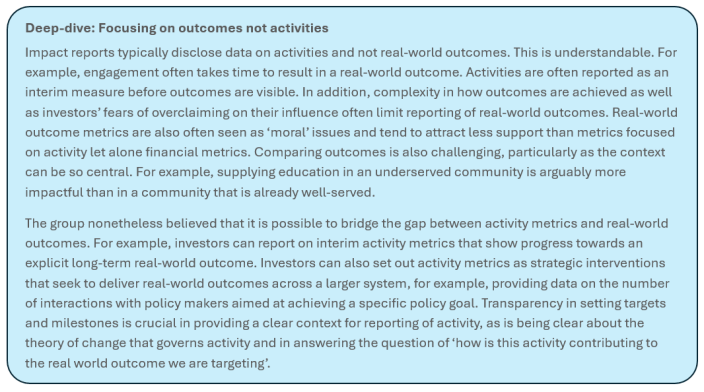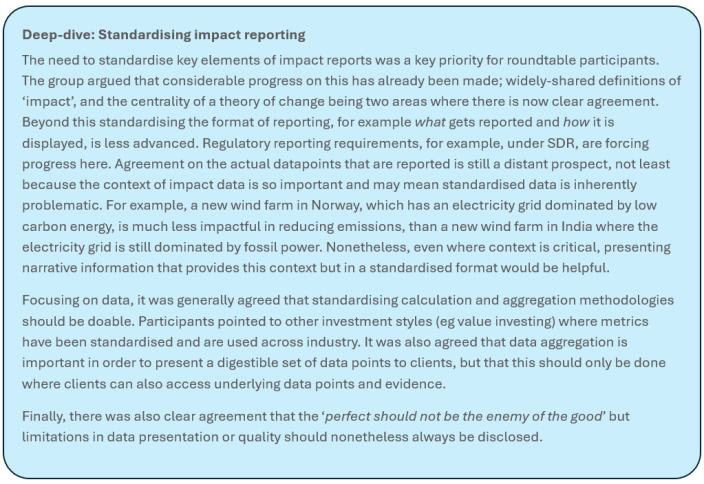Roundtable on the future of impact reporting in listed equities


In late February, WHEB convened a select group of clients, consultants, data providers and fund selectors to discuss the future of impact reporting in listed equities (see attendee list below). Since WHEB’s first report in 2014, reports have grown dramatically in length and sophistication. From just one data point on carbon emissions in that first report, by 2024 WHEB’s report contained 23 separate carbon data points. Many of these are now required by clients and even regulators. After a decade of practice, it was time to take stock and reflect on where impact reporting has come from and where it might be going.
After an initial wide-ranging conversation, participants then focused on two areas: standardisation and the reporting of real-world outcomes. The key headlines from the roundtable were:
1. Impact reporting fulfils a key purpose
At least in WHEB’s case, impact reports are very popular. They are widely read by clients and consultants as well as NGOs, employees, business partners and peers. Their fundamental purpose is to enable clients and other stakeholders to hold us to account and answer the question, ‘are we doing what we said we would do’? Metrics and case studies that provide evidence that underpin claims of positive impact have become much more common, but further improvements in the robustness and accuracy of this data is still needed. Furthermore, it was suggested that reports should not just seek to justify and explain activity, but also to serve as a mechanism for learning and improvement.
2. A clear theory of change underpins impact reporting
Setting out a clear theory of change (ToC) is now firmly established as a core requirement for impact investments. This may be done at the level of the portfolio overall but will also be evident in each individual investment influencing how ultimate outcomes get reported (see below).
3. Standardisation emerged as the key next step in impact reporting
The need to standardise reporting formats and metrics (see below) to add comparability and manage complexity was a high priority among the group and particularly important for advisers and other intermediaries who want to compare performance between different funds. However, standardising while not losing the ability to provide context was seen as a key tension.
4. Materiality as a key organising principle
As impact reporting has become more popular, so demand for more data has also grown. This is now reaching a point of overload with a need to refocus on relevant – or material – data.
5. The impact report as one element in effective communication
Different audiences have different needs and impact reports on their own will not meet all these needs. Some audiences prefer storytelling and narrative that makes impact investing accessible. Others prefer detailed descriptions of investment processes and metrics that underpin the credibility of the approach and combat greenwashing concerns. The impact report is one element that can support effective communication but needs to be complemented by other communication tools.
6. Focusing on outcomes
While there was a clear emphasis on standardising reports, one area where more innovation is still needed is in developing effective ways of measuring the real-world outcomes that are associated with impact investments (see below).


With thanks to our roundtable participants:
Archie Cage, Tribe Impact Capital
Bella Landymore, Impact Investing Institute
Conor McQuistin, Net Purpose
Dillon Piggott, East Sussex Pension Fund
Helen Wiggs, ShareAction
Jake Moeller, Square Mile Investment Consulting and Research
Jordan Griffiths, Barnett Waddingham
Matthias Lomas, Guy’s and St Thomas’ Foundation
Paige Nicol, BlueMark
Sign up here to receive our monthly and quarterly commentaries in your inbox.
